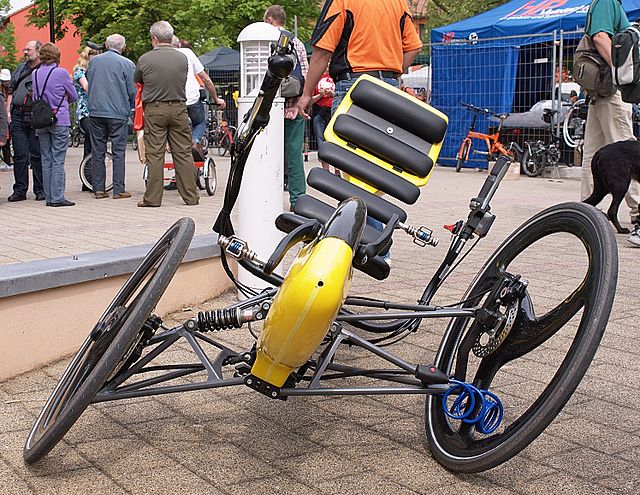Countersteering is used by single-track vehicle operators, such as cyclists and motorcyclists, to initiate a turn toward a given direction by momentarily steering counter to the desired direction. To negotiate a turn successfully, the combined center of mass of the rider and the single-track vehicle must first be leaned in the direction of the turn, and steering briefly in the opposite direction causes that lean. The rider's action of countersteering is sometimes referred to as "giving a steering command".
Graphs showing the lean and steer angle response of an otherwise uncontrolled simplified model of a typical bike, traveling at a forward speed in its stable range (in this case 6 m/s), to a positive steer torque (to the right) that begins as an impulse and then remains constant. It causes an initial steer angle to the right, a lean to the left, and eventually a steady-state lean to the left, steer angle to the left, and thus a turn to the left.
Tripendo recumbent tricycle, a tilting three-wheeler
Motorcycle speedway racing
A tilting three-wheeler, tilting trike, leaning trike, or even just tilter, is a three-wheeled vehicle and usually a narrow-track vehicle whose body and or wheels tilt in the direction of a turn. Such vehicles can corner without rolling over despite having a narrow axle track because they can balance some or all of the roll moment caused by centripetal acceleration with an opposite roll moment caused by gravity, as bicycles and motorcycles do. This also reduces the lateral acceleration experienced by the rider, which some find more comfortable than the alternative. The narrow profile can result in reduced aerodynamic drag and increased fuel efficiency. These types of vehicles have also been described as "man-wide vehicles" (MWV).
Vandenbrink Carver (1F1T)
Tripendo recumbent tricycle, a tilting three-wheeler (2F3T)
Yamaha Niken from 2018
UWM PantherTrike, a narrow-track, tilting, recumbent, human-powered trike (1F3T)






